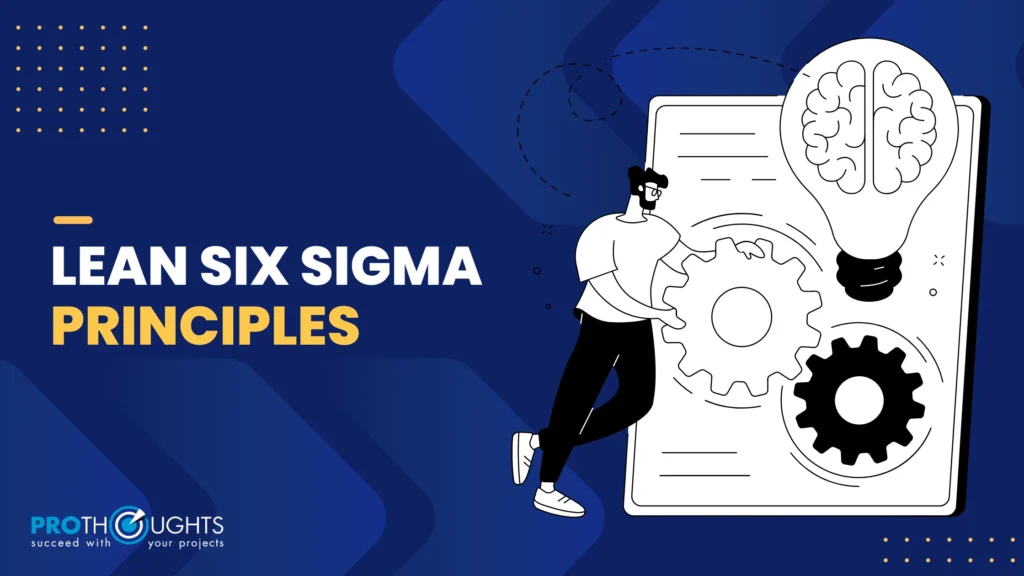Lean Six Sigma is the tried-and-tested method to achieve the best results in quality and process efficiency. It is driven by 5 core principles – known as the Lean Six Sigma Principles.
Six Sigma has been the standard for years and has consistently helped brands build better products and keep customers happy. In this blog, we’ll introduce you to Lean Six Sigma Principles which serve as the foundation to achieve these results!
What is Lean Six Sigma?
Lean Six Sigma is an improvement-based methodology that helps achieve quality in production and efficiency in organizational processes to deliver customer satisfaction.
It is a combination of two popular frameworks – Lean and Six Sigma. See the difference here: Lean vs Six Sigma.
What is Lean?
Lean is a mindset that focuses on improving organizational procedures by getting rid of all kinds of waste. It helps by maximizing the use of resources to attain customer satisfaction. The main objective of Lean is to seek value from the customer’s standpoint and continuously focus on improving all business processes.
Lean can be used in all environments that generate waste to optimize quality, including manufacturing and service-related sectors.
What is Six Sigma?
Six Sigma is a process improvement methodology. It uses statistical tools and management techniques to recognize any variation and improve the efficiency of business processes. It helps to deliver quality products and services to customers.
Six Sigma was originally extracted from the bell curve in statistics, in which sigma denoted the standard deviation from the mean. When a process is optimized and operates at the Six Sigma level, it is typically designed to maintain zero errors. More precisely, there are only 3.4 chances in a million opportunities for a variation to occur.
To summarize:
Lean is a mindset that focuses on eliminating waste from the manufacturing or operational processes. On the other hand, Six Sigma focuses on following principles aligned with improving the quality of the products and services to achieve near-zero defects.
Integrating a Lean mindset with the Six Sigma principles results in the Lean Six Sigma Methodology.
LSS is helpful for modern-day organizations dealing with the supply of finite resources and the abundance of products in the market. It helps organizations stand out from the competition by creating products that exactly match customer demands.
What are Lean Six Sigma Principles?
Lean Six Sigma blends the best operational excellence methodologies of Six Sigma and Lean to optimize business processes for efficiency and quality management. Though Lean and Six Sigma differ in their approaches, they complement each other because they serve the same purpose of driving customer satisfaction.
Upon using LSS, businesses can get insights into their operations by employing statistical tools and approaches. It allows them to make decisions that result in concrete changes. To better understand how LSS functions, it is necessary to understand the primary principles that govern the implementation of LSS in any process.
5 Principles of Lean Six Sigma
LSS gives you the best of both worlds to achieve better quality while getting rid of any kind of waste. The 5 principles that guide this implementation of Lean Six Sigma are as follows:
1. Focus on the Customer
The foundation of Lean Six Sigma is the outlook of the customer. All organizations must aim to constantly focus on the demands and needs of the customer. Before making any changes to the process, it is essential to understand the reason for doing it and the customer should always be at the center of the reason.
2. Identify Key Challenges and Zero In
Effectively defining the problem is essential to the LSS Framework. To better tune the process to optimal standard, it is important to focus on the problems that hinder the productivity of the process. This involves reviewing data to identify root causes of problems and prioritizing them according to their importance. It is also essential to not lose sight of the initial challenges while applying any change in the processes.
3. Defect Reduction and Simplify Workflows
Upon recognizing the problem, you need to adapt the tools and methodologies that help remove these defects and variations to the process. The goal of Six Sigma and Lean is to ensure an error-free process by defect reduction. Both focus on removing variability and waste while seeking near perfection in processes.
To support these strategies, organizations must use the best methods powered by Lean Six Sigma Principles. This helps remove any dispensable and redundant steps and achieve the most standardized level of those processes.
4. Institutionalize the Principles
The central theory of the Lean Six Sigma principle is optimizing all the processes. For that, all project teams in the organization need to be proficient in LSS, know the objectives of the projects, and be aware of the developments happening. For this, organizations must train all parties contributing to the process. Employees who are competent with the LSS principles can better support the improvement initiatives of the business.
5. Adapt Swiftly
Change and Lean Six Sigma go hand in hand. It is essential to adapt promptly when an error or variation is identified to improve and establish consistency in the process. LSS aims to eliminate ineffective methods to achieve flow and make business practices error-free.
Enforcing change at a swift pace ensures steady improvement that results in saving time and other resources.
How to apply Lean Six Sigma Principles?
The LSS Principles are useful and meant to work in several sectors to resolve organizational and process challenges, customer relations, ROI, and way of working. Drawing from McGraw Hill’s book on Lean Six Sigma, the implementation process consists of three phases – setting the goal for the quality initiative, post-strategy alignment & awareness of everyone involved, and culture “rollout”.
Set The Goal
The first phase is to tune the LSS with the specific quality goal considered for improvement This step includes determining a target area and establishing the required organizational structure. A crucial milestone at this stage is to define a clear plan for the quality program.
The approach should include:
- Well-defined aims and objectives.
- Resources required to carry out the plan.
- A defined timeline for sustaining efforts.
- Success metrics to measure the effectiveness of the initiative.
- A talent pipeline ensures effective training and project execution.
- Focus on topics that will produce both rapid results and address ongoing business difficulties.
End-to-end Alignment
In this phase, you train the leaders of the initiative, establish metrics, and identify key projects.
It is important to raise awareness of the initiative throughout the organization. It includes developing a communication strategy, training employees, and sharing the vision for the same.
Engaging key stakeholders and developing a change management strategy is also necessary for reducing all kinds of risks.
The Key Actions include –
- Quick wins to build momentum.
- Building teams to guarantee broad involvement and significant results.
- Training employees at all levels.
- Appreciating and rewarding success to highlight the significance of the initiative.
- Promoting Six Sigma Green Belts and Black Belts who have produced tangible results.
Culture “Rollout” of the Lean Six Sigma Principles
The final phase of implementing LSS involves the adoption of the principles in the company’s culture. By this stage, staff are fully trained, and metrics are in place to guide decision-making. The challenge now is to ensure the organization has the necessary tools and resources for continued success.
We’ll now look into the respective methodologies of Six Sigma and Lean for quality excellence and process improvement. These methodologies are widely accepted for Lean and Six Sigma implementation.
Six Sigma Framework
Six Sigma uses DMAIC or DMADV problem-solving approaches to remove defects in any organization’s processes. Let’s learn more about what the abbreviation stands for and its objectives.
DMAIC is used for the already implemented processes and seeks to improve them via its phases when detected with a defect. The five phases of this Six Sigma Methodology are as follows:
- Define: Identify and Define the problem that needs to be addressed.
- Measure: Use the statistical tools to measure and collect data relevant to the problem.
- Analyze: Use the data to analyze the cause of the problem or defects that are to be improved.
- Improve: After properly contemplating the defect or problem, develop, test, and apply solutions to tackle them.
- Control: Apply quality controls to maintain the improvements.
DMADV, on the other hand, seeks to design or redesign processes for better quality control. The abbreviation stands for the following five phases:
- Define: Define the objectives of design goals.
- Measure: Assess and determine the quality needs of the product, services, or processes in quantifiable data for further analysis.
- Analyze: Use the data to develop the best design concepts.
- Design: The concepts evaluated in the analysis phase are used to create an early design prototype that will be validated in the later phase.
- Verify: During this phase, the detailed design is tested for everyday use to ensure that the goals established at the start of the design process are met by the design outcomes.
Lean Framework
Lean Mindset functions on principles that help organizations understand the value and refine their process accordingly. Businesses can merge lean into their operations by applying these principles broadly to the organization.
- Value Identification: The first stage in the Lean framework is to define value from the customer’s perspective. Understanding customer’s needs and demands is the key for businesses to align their products and services accordingly.
- Value Stream Mapping: Once the value has been identified, the next step is to estimate the current processes using value stream mapping. This technique visually depicts all phases in a process and identifies waste sources.
- Waste Elimination: After the source of waste is known, Lean seeks to eliminate waste. Lean specifies eight kinds of waste summed up by the acronym DOWNTIME. It stands for Defect, Overproduction, Waiting, Non-Utilized Talent, Transportation, Inventory, Motion, and Extra Processing.
- Pull System: Lean also promotes sustainable use of resources by focusing on using the pull system for manufacturing processes. A pull system produces goods based on actual demand. It helps in reducing excess inventory and ensures that there is an efficient use of resources.
- Kaizen: Lean promotes a culture of continuous improvement in an organization. This philosophy is called Kaizen, which can foster a work culture that focuses on making gradual improvements leading to better long-term results.
How Lean Six Sigma Principles Help Your Business
Lean Six Sigma is built on the idea that businesses need to have a thorough awareness of both their internal processes and their customer’s present and future needs to provide exceptional service and products.
Even though Lean and Six Sigma are two separate methods and principles, their combination has produced a method that is more adaptable and useful for solving business problems. LSS can help businesses in the ways mentioned below:
- Efficient Processes: Lean Six Sigma Principles ensure process efficiency in all business activities as it follows zero-waste, variation-free procedures.
- Improved Customer Satisfaction: Central to LSS principles is focusing on the demands and needs of the customer which ensures that the product and services satisfy your customers.
- Quality Product: As the process improves, the quality also improves resulting in the development of standardized and quality products.
- Cost Reduction: Eliminating inefficient activities naturally conserves resources, which aids in cost reduction.
- Find Solutions Strategically: As the LSS principles are highly structured and defined, they guide the problem toward finding strategic solutions.
Conclusion
If you want your business to shift from traditional operations to advanced process management, Lean Six Sigma is for you. Using Lean Six Sigma can assist in increasing ownership, quality control, consistency, and transparency in operational processes.
To improve the organization’s way of working, Corporate Training is the best place to start. For individuals with a keen understanding of processes and experience in quality management, Six Sigma Certifications are the way to go.


